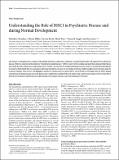| dc.contributor.author | Sawa, Akira | |
| dc.contributor.author | Korth, Carsten | |
| dc.contributor.author | Millar, J. Kirsty | |
| dc.contributor.author | Brandon, Nicholas J. | |
| dc.contributor.author | Singh, Karuna | |
| dc.contributor.author | Sive, Hazel L. | |
| dc.date.accessioned | 2010-06-03T19:47:18Z | |
| dc.date.available | 2010-06-03T19:47:18Z | |
| dc.date.issued | 2009-08 | |
| dc.date.submitted | 2009-07 | |
| dc.identifier.issn | 0270-6474 | |
| dc.identifier.uri | http://hdl.handle.net/1721.1/55390 | |
| dc.description.abstract | The biology of schizophrenia is complex with multiple hypotheses (dopamine, glutamate, neurodevelopmental) well supported to underlie the disease.Pathways centered on the risk factor “disrupted in schizophrenia1”(DISC1)maybe able to explain and unite these disparate hypotheses and will be the topic of this mini-symposium preview. Nearly a decade after its original identification at the center of a translocation breakpoint in a large Scottish family that was associated with major psychiatric disease, we are starting to obtain credible insights into its function and role in disease etiology. This preview will highlight a number of exciting areas of current DISC1 research that are revealing roles for DISC1 during normal brain development and also in the disease state. Together these different threads will provide a timely and exciting overview of the DISC1 field and its potential in furthering our understanding of psychiatric diseases and in developing new therapies. | en |
| dc.language.iso | en_US | |
| dc.publisher | Society for Neuroscience | en |
| dc.relation.isversionof | http://dx.doi.org/10.1523/jneurosci.3355-09.2009 | en |
| dc.rights | Article is made available in accordance with the publisher's policy and may be subject to US copyright law. Please refer to the publisher's site for terms of use. | en |
| dc.source | Society for Neuroscience | en |
| dc.title | Understanding the Role of DISC1 in Psychiatric Disease and during Normal Development | en |
| dc.type | Article | en |
| dc.identifier.citation | Brandon, Nicholas J. et al. "Understanding the Role of DISC1 in Psychiatric Disease and during Normal Development." Journal of Neuroscience (2009) 29(41): 12768 –12775. © 2009 Society for Neuroscience. | en |
| dc.contributor.department | Massachusetts Institute of Technology. School of Science | en_US |
| dc.contributor.department | Picower Institute for Learning and Memory | en_US |
| dc.contributor.approver | Sive, Hazel L. | |
| dc.contributor.mitauthor | Singh, Karuna | |
| dc.contributor.mitauthor | Sive, Hazel L. | |
| dc.relation.journal | Journal of Neuroscience | en |
| dc.eprint.version | Final published version | en |
| dc.type.uri | http://purl.org/eprint/type/JournalArticle | en |
| eprint.status | http://purl.org/eprint/status/PeerReviewed | en |
| dspace.orderedauthors | Brandon, N. J.; Millar, J. K.; Korth, C.; Sive, H.; Singh, K. K.; Sawa, A. | en |
| dc.identifier.orcid | https://orcid.org/0000-0002-4890-424X | |
| mit.license | PUBLISHER_POLICY | en |
| mit.metadata.status | Complete | |
